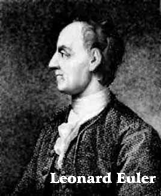"Liesez Euler, Liesez Euler, c'est notre maître à tous"
("Read Euler, read Euler, he is our master in everything") - Laplace
I should say here that the post by Guest post: Marni D. Sheppeard, “Is Category Theory Useful ?” over at A Quantum Diaries Survivor, continues to invoke my minds journey into the abstract spaces of mathematics.
 The river Pregel divides the town of Konigsberg into four separate land masses, A, B, C, and D. Seven bridges connect the various parts of town, and some of the town's curious citizens wondered if it were possible to take a journey across all seven bridges without having to cross any bridge more than once. All who tried ended up in failure, including the Swiss mathematician, Leonhard Euler (1707-1783)(pronounced "oiler"), a notable genius of the eighteenth-century.
The river Pregel divides the town of Konigsberg into four separate land masses, A, B, C, and D. Seven bridges connect the various parts of town, and some of the town's curious citizens wondered if it were possible to take a journey across all seven bridges without having to cross any bridge more than once. All who tried ended up in failure, including the Swiss mathematician, Leonhard Euler (1707-1783)(pronounced "oiler"), a notable genius of the eighteenth-century.As a lay person being introduced to the strange world of mathematics it is always interesting to me in the way one can see in abstract processes.
 The Beginnings of Topology...The Generalization to Graph Theory
The Beginnings of Topology...The Generalization to Graph TheoryEuler generalized this mode of thinking by making the following definitions and proving a theorem:
Definition: A network is a figure made up of points (vertices) connected by non-intersecting curves (arcs).
Definition: A vertex is called odd if it has an odd number of arcs leading to it, other wise it is called even.
Definition: An Euler path is a continuous path that passes through every arc once and only once.
Theorem: If a network has more than two odd vertices, it does not have an Euler path.
Euler also proved the converse:
Theorem: If a network has two or less odd vertices, it has at least one Euler path.
Leonhard Paul Euler (pronounced Oiler; IPA [ˈɔʏlɐ]) (April 15, 1707 – September 18 [O.S. September 7] 1783) was a pioneering Swiss mathematician and physicist, who spent most of his life in Russia and Germany. He published more papers than any other mathematician of his time.[2]
Euler made important discoveries in fields as diverse as calculus and graph theory. He also introduced much of the modern mathematical terminology and notation, particularly for mathematical analysis, such as the notion of a mathematical function.[3] He is also renowned for his work in mechanics, optics, and astronomy.
 Portrait by Johann Georg Brucker- Born April 15, 1707(1707-04-15)Basel, Switzerland and Died September 18 [O.S. September 7] 1783
Portrait by Johann Georg Brucker- Born April 15, 1707(1707-04-15)Basel, Switzerland and Died September 18 [O.S. September 7] 1783St Petersburg, Russia
You have to understand that as a lay person, my education is obtained through the internet. This is not without years of study(many books) in a lot of areas, that I could be said I am in a profession of anything, other then the student, who likes to learn a lot.
To find connections between the "real world" and what a lot think of as "to abstract to be real."
Any such expansionary mode of thinking, if not understood, as in the Case of Riemann's hypothesis seen in relation to Ulam's Spiral, one might have never understood the use of "Pascal's triangle" as well.
These are "base systems of mathematics" that are describing processes in nature?
See:Euler - 300th anniversay lecture

No comments:
Post a Comment